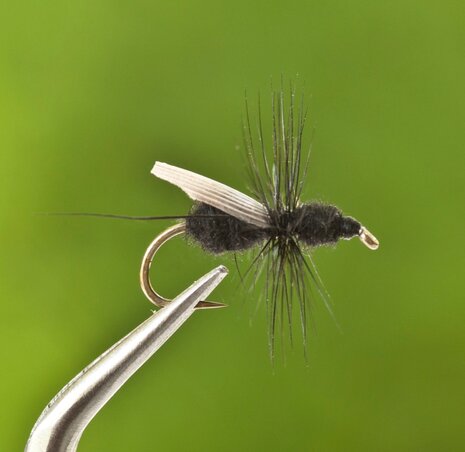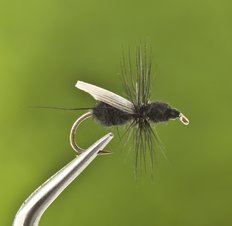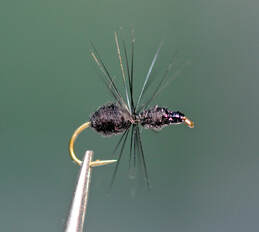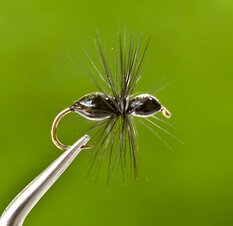Fly of the Month
Fly fishing during the dog days of summer tend to be a challenge. Water temperatures in the Southern Appalachians in our headwater streams are marginally high for trout. On many of our lower elevation Delayed Harvest Stream the water temperatures reach the high 70s and in places over 80 degrees and trout must seek any cooler, deeper hides or risk suffocation due to a lack of sufficient dissolved oxygen.
With warmer water temperature and low dissolved oxygen, aquatic insect activity slows down to bottom survival of the nymph stage and a rarity of any type of hatch. The primary aquatic insect hatch during the early summer are little yellow and little green stoneflies in the afternoon and golden stoneflies during the night. The most abundant insects all summer for trout are terrestrials and specifically ants and beetles.
Black Ant
During the cold, winter months of December thru March in the Southern Appalachians, winter stoneflies flourish when there are few other aquatic or terrestrial insects around. Depending on local nomenclature, these insects may be called Early Winter Stones, Small Winter Blacks, Willowflies, Snow Bugs or Snow Fleas. Winter stoneflies hatch systematically during the winter months much like most other aquatic insects hatch during the spring, summer or fall.
There are thousands of species and eighteen categories of ants world-wide. These categories are a layman’s view of groups of ants based on their odd behaviors and interesting adaptations: Citronella, Field, Carpenter, Thief, Fire, Harvester, Amazon, Leafcutter, Crazy, Odorous House, Honeypot, Army, Bullet, Acacia, Pharaoh, Trap Jaw, Acrobat and Weaver. These category names provide a hint as to their claim to fame, for example Thief Ants tend to be the very tiny “piss ants” that appear at your picnic, attempting to rob you of your food. For the most part, anglers encounter Field, Carpenter, Fire, Harvester and Acrobat ants near and around streams. Yes, there are actually North American native species of Fire ants in which most tend to be red cinnamon or brown in color. Harvester ants may be brown, gray, cream or even yellow in color. Acrobat ants are typically black with a heart shaped abdomen that gets raised when threated. Many species of black ants have similar species that are brown in color, but black is the most dominate of ant colors. Overall the Field Formicidae family and Carpenter Camponotus genus ants are the most predominant along a stream bank.
Fly fishing during the dog days of summer tend to be a challenge. Water temperatures in the Southern Appalachians in our headwater streams are marginally high for trout. On many of our lower elevation Delayed Harvest Stream the water temperatures reach the high 70s and in places over 80 degrees and trout must seek any cooler, deeper hides or risk suffocation due to a lack of sufficient dissolved oxygen.
With warmer water temperature and low dissolved oxygen, aquatic insect activity slows down to bottom survival of the nymph stage and a rarity of any type of hatch. The primary aquatic insect hatch during the early summer are little yellow and little green stoneflies in the afternoon and golden stoneflies during the night. The most abundant insects all summer for trout are terrestrials and specifically ants and beetles.
Black Ant
During the cold, winter months of December thru March in the Southern Appalachians, winter stoneflies flourish when there are few other aquatic or terrestrial insects around. Depending on local nomenclature, these insects may be called Early Winter Stones, Small Winter Blacks, Willowflies, Snow Bugs or Snow Fleas. Winter stoneflies hatch systematically during the winter months much like most other aquatic insects hatch during the spring, summer or fall.
There are thousands of species and eighteen categories of ants world-wide. These categories are a layman’s view of groups of ants based on their odd behaviors and interesting adaptations: Citronella, Field, Carpenter, Thief, Fire, Harvester, Amazon, Leafcutter, Crazy, Odorous House, Honeypot, Army, Bullet, Acacia, Pharaoh, Trap Jaw, Acrobat and Weaver. These category names provide a hint as to their claim to fame, for example Thief Ants tend to be the very tiny “piss ants” that appear at your picnic, attempting to rob you of your food. For the most part, anglers encounter Field, Carpenter, Fire, Harvester and Acrobat ants near and around streams. Yes, there are actually North American native species of Fire ants in which most tend to be red cinnamon or brown in color. Harvester ants may be brown, gray, cream or even yellow in color. Acrobat ants are typically black with a heart shaped abdomen that gets raised when threated. Many species of black ants have similar species that are brown in color, but black is the most dominate of ant colors. Overall the Field Formicidae family and Carpenter Camponotus genus ants are the most predominant along a stream bank.
Harrop’s Flying Ant
HOOK : Tiemco 100 or equivalent size : 12,14,16,18,20
Thread : Uni 8/0 black
Abdomen : Black dubbing
Wing : Mallard Primary
Thorax hackle : Black Rooster
Thorax : Black Hackle
Stabilizers : Moose Mane
Directions :
- Debarb the hook and mount in the vise. Begin the thread two eyelengths from the eye and wrap to the hook bend in tight, touching turns. Let the bobbin hang.
- Dub the thread with black dubbing and begin a tapered wrap. Start at the hook bend and advance to slightly ahead of the third mark. Do not try to use to much dubbing in order to have control of the shape and size. The shape is to be oval, so build up the dub in the middle of the abdomen to form the shape, ending back in front of the now formed abdomen. Let the bobbin hang.
- Select a small (1/4) gray mallard section and trim from the quill. The trimmed end should be square cut. Size the length of the wing at the hook and then trim the shape of the length by cutting two diagonals on the end not squared already. Tie in the wing on top of the hook shank using the touch method. Make sure the length is right (slightly past the abdomen) and centered on top of the hook shank. Secure with several thread wraps and let the bobbin hang.
- Select a black rooster hackle with barbs about one hook gape in length. Strip the end of the stem of barbs and tie in immediately in front of the abdomen. Shiny side to the front. Wrap in tight, touching turns to where the thorax will begin. Three or four turns. Let the bobbin hang.
- Select two moose hairs that are stiff for what will be the entire tie in. Moose will become grey after black tips. The tips are stiff with the grey being softer. Tie in with the tips toward the abdomen, on either side of the hook shank, immediately in front of the black hackle. Tie in just that black portion of moose so that the moose extends slightly past the abdomen. Trim waste.
- Dub the thorax like the abdomen only slightly smaller.
- Form a small thread head, whip finish and done.
Hard Body Black Ant
HOOK : Tiemco 100 or equivalent size : 12,14,16,18,20
Thread : Uni 8/0 black
Abdomen : Black dubbing
Thorax hackle : Black Rooster
Thorax : Black Hackle
Directions :
- Debarb the hook and mount in the vise. Begin the thread two eyelengths from the eye and wrap to the hook bend in tight, touching turns. Let the bobbin hang.
- Dub the thread with black dubbing and begin a tapered wrap. Start at the hook bend and advance to slightly ahead of the third mark. Do not try to use to much dubbing in order to have control of the shape and size. The shape is to be oval, so build up the dub in the middle of the abdomen to form the shape, ending back in front of the now formed abdomen. Let the bobbin hang.
- Select a black rooster hackle with barbs about one hook gape in length. Strip the end of the stem of barbs and tie in immediately in front of the abdomen. Shiny side to the front. Wrap in tight, touching turns to where the thorax will begin. Three or four turns. Let the bobbin hang.
- Dub the thorax like the abdomen only slightly smaller.
- Form a small thread head, whip finish and done.
- Use your favorite brand of UV resin to cover the abdomen and the thorax.




